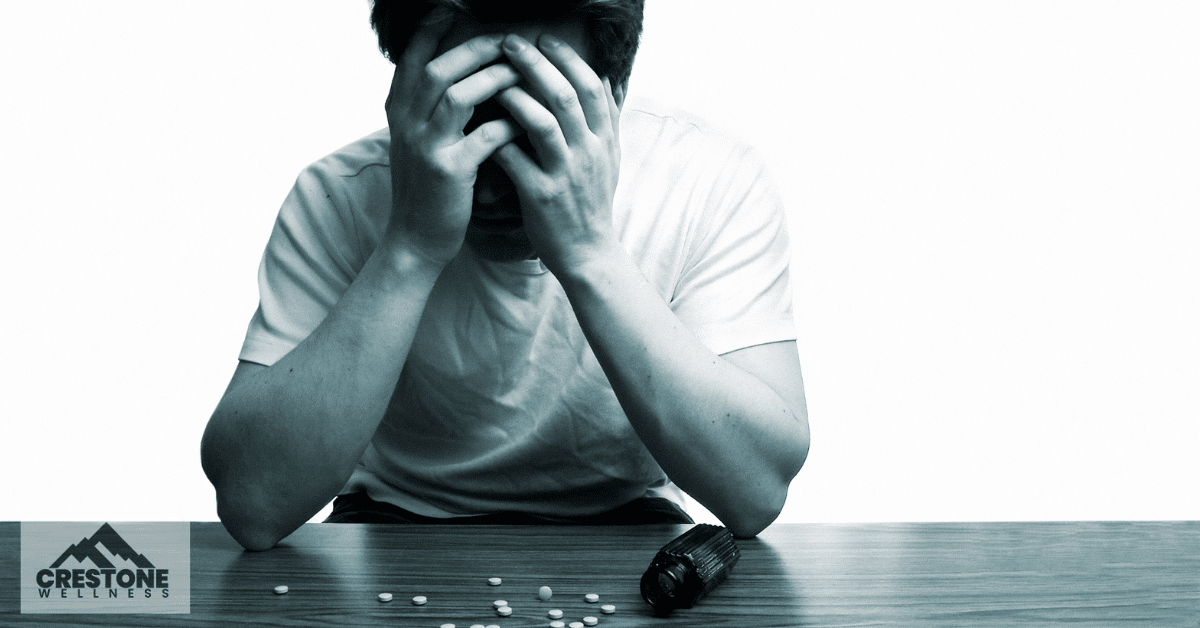A 2020 study by the Substance Abuse and Mental Health Services Administration (SAMHSA) on drug use in the United States found that 59.3 million people participated in drug abuse in some way, including the misuse of prescription medication.
Xanax, usually referred to by its generic name Alprazolam, is a benzodiazepine that is frequently prescribed for panic disorders and anxiety symptoms that was first used in the 1970s. With around one prescription being written every second, it is the most commonly administered psychiatric medication in the United States.
This indicates that Xanax is generally accessible and affordable for many people. Although it has genuine uses, it’s highly addictive and frequently abused. In fact, statistics show that as many as 44 percent of chronic benzodiazepine users become addicted to one of these drugs.
If you have ever tried to stop using Xanax after developing physical dependence, you might experience severe withdrawal symptoms. In this article, we’ll take a closer look at Xanax addiction, its associated withdrawal symptoms, and how long Xanax withdrawal lasts.
What Is Xanax?
Xanax is a fast-acting, potent tranquilizer used to treat the following conditions:
- Generalized anxiety disorder
- Insomnia
- Panic attacks and panic disorder
- Other mental health conditions
How does this drug work? Xanax and other benzodiazepine drugs promote the synthesis of the neurotransmitter GABA. GABA is in charge of making us feel at ease and calm. The synthesis of GABA may not be effectively regulated when you suffer from an anxiety disorder, which is why Xanax can be helpful in easing the associated symptoms of anxiety.
Additionally, Xanax works to decrease and relax the central nervous system and calm brain activity. This can also help to reduce stress, tension, and anxiety.
Signs of Xanax Addiction

If you suspect that you or someone you love may be addicted to Xanax, there are certain tell-tale signs you can look out for. People that take excessive amounts of the drug often experience the following:
- Confusion
- Slurred speech
- Weakness
- Dizziness
- Blurred vision
- Confusion
- Difficulty breathing
- Lack of motor coordination
- Dependency and addiction
- Withdrawal from friends and family
When it comes to Xanax, bodily withdrawal symptoms occur when the drug is stopped. This is one of the most prominent signs of physical dependence. A few typical side effects are headaches, nausea, vomiting, excessive perspiration, impaired vision, and convulsions.

As the person’s body becomes accustomed to the drug, dependence gradually sets in. Without it, the body may begin to filter the material out, and the person may experience generalized aches. Mild over-the-counter painkillers can be used to address this discomfort.
Because Xanax overuse can lead to life-threatening conditions, such as difficulty breathing and even coma, it is essential to seek help if you or a loved one are addicted to this prescribed medication.
How Xanax Addiction Affects Different Groups
Although drug dependence can affect anyone, some groups of people are more likely than others to develop it. In the section below, we’ll explore how Xanax affects different people and the likelihood of certain groups developing a dependency on the drug.
Gender

It is believed that women are more likely than men to get addicted to Xanax, although this could simply be because women are more likely to get a prescription for the medication. There are twice as many women as men who use these drugs.
Age
Age also has a significant impact on prescription trends. According to a National Institutes of Health survey from 2008, only 2.6 percent of individuals between the ages of 18 and 35 and 8.7 percent of those between the ages of 65 and 80 used benzodiazepines.

Use
If an individual takes too much Xanax or abuses it excessively, dependency is more likely to develop. However, Xanax addiction can happen to even prescription drug users who follow the suggested dosing regimen. Because the other drugs they use frequently amplify the effects of the drug, those who abuse multiple substances are far more likely to become addicted.

Understanding Addiction and Benzodiazepine Withdrawal Symptoms
Before delving into the withdrawal symptoms, it may be helpful to first understand how Xanax addictions occur and why users experience withdrawal symptoms when they stop taking the medication.
Xanax addiction and substance use disorder occurs the same way that most other addictions happen. In essence, the chemical increases the release of dopamine through changing neuronal communication across the brain.
As a naturally occurring neurotransmitter, dopamine is linked to sensations of satisfaction and relaxation. A stronger-than-normal dopamine spike, like the one that accompanies most drug usage, may cause a powerful, euphoric high that increases the urge for repeated use.
However, when a user decides to stop taking the medication, the brain must return to its normal, pre-drug state, which gives rise to the cluster of symptoms often referred to as benzodiazepine withdrawal syndrome.
Common Xanax Withdrawal Symptoms

The symptoms of Xanax withdrawal that you will experience when you stop taking this prescribed medication will vary depending on a number of factors, including age, frequency of use, and more. Because it affects the central nervous system, when you stop taking the drug, it could cause symptoms that range from mild to severe. We’ll discuss them in the section below.
Mild Symptoms
When you stop taking benzodiazepines, you will experience certain acute symptoms. These can be categorized as psychological and physical withdrawal symptoms.
Psychological Symptoms of Xanax Withdrawal
Here are some of the psychological and emotional symptoms associated with Xanax withdrawal:
- Rebound anxiety
- Irritability
- Fear or paranoia
- Heightened senses
- Sleeplessness
- Suicidal thoughts
- Panic attacks and anxiety disorders
Physical Symptoms
In addition to these psychological symptoms, users may also experience the following bodily symptoms:
- Muscle pain and aches
- Hypertension
- Blurred vision
- Numbness in the fingers
- Headaches
- Tension in the jaw
- Teeth pain
- Tremors
- Diarrhea
- Cramps
- A tingling sensation in the legs and arms
- Loss of appetite
- Fever
- Excessive perspiration
- Changes in the sense of smell
- Sensitivity to sound and light
Severe Withdrawal Symptoms
Xanax withdrawal can also cause serious, life-threatening symptoms, such as an elevated heart rate and seizures. This is why it is important to get help when you stop taking Xanax.
At Crestone, we understand how severe Xanax withdrawal symptoms can be, which is why we keep a close eye on sufferers as they take their lives back and receive the addiction treatment they need.
How Long Does Xanax Withdrawal Last?

The time it takes to wean off benzodiazepines is influenced by numerous factors. Some of these variables include the age of the person and the length and intensity of the drug misuse phase. People who have used substances for extended periods often experience more severe withdrawal symptoms.
Long-term Xanax users can usually anticipate withdrawal symptoms for at least five days. Moreover, certain underlying conditions can also impact the duration of withdrawal symptoms.
Xanax Withdrawal Timeline
Four phases of withdrawal are what anyone wishing to start treatment to wean themselves off Alprazolam can anticipate. Moreover, the duration and severity change according to the user’s unique brain chemistry and conditions. The standard withdrawal process can look like this:
Stage One
Within 6 to 12 hours of the person’s final dose, the first acute Xanax withdrawal symptoms frequently start to manifest. Anxiety and insomnia are commonplace during this stage of withdrawal and are often the first ones a person may encounter.
Stage Two
This stage, which typically lasts for one to four days on average, is marked by persistent anxiety and insomnia, which are frequently accompanied by symptoms such as diarrhea, nausea, and vomiting.
Stage Three
The symptoms associated with stages one and two frequently last an additional 5 to 14 days during this stage. Usually, no new symptoms appear.
Stage Four
The final step can be the most difficult for some sufferers since it can cause undesired psychological disorders to reappear. It’s possible that the mental health disorders the drug was intended to treat will reappear along with anxiety symptoms and other rebound effects. Users often experience this stage of withdrawal roughly two weeks after taking their last dose of the medication.
Xanax Addiction Treatment

To help you stop using Xanax, our treatment plan involves a two-pronged approach.
1. Detox
It’s vital to decrease your use rather than quit cold turkey when detoxing from Xanax. Your chance of developing serious withdrawal symptoms rises if you stop using the drug suddenly, and doing so can be very bad for your health.
The withdrawal symptoms you encounter may be lessened by tapering your Xanax dosage. In fact, some people report that when they reduce their usage, they don’t experience any withdrawal symptoms.
Although you can detox from this substance without medical supervision, being in a treatment program is the safest option. By doing so, you can be confident that you’re supporting your body throughout the detox process and that help is available if symptoms become life-threatening.
2. Behavioral Therapy
In addition to ridding your body of the substance, you will receive behavioral therapy when you use our treatment facility in Austin, TX. This involves addressing addictive behaviors, identifying triggers, and dealing with mental disorders that caused you to start taking Xanax in the first place.
Life After Xanax

The first step in recovering from addiction is to treat the presenting disorder, which is typically a severe type of anxiety, to prevent the individual from relapsing into Xanax use or turning to another form of self-medication. This is one of the reasons why the entire withdrawal process must be carried out in conjunction with medical and addiction treatment experts.
Other symptoms can sporadically appear even after the most harmful ones have subsided and the existing anxiety has been controlled. Short-term memory issues, headaches, a lack of coordination, muscle pain, and stomach cramps have all been reported by Xanax addicts in recovery.
These issues result from the drug’s damaging effects on the brain from excessive usage. Mild paranoia, sporadic depression, impatience, lack of concentration, and lingering problems with destroyed relationships were among the emotional symptoms that occasionally persisted after the withdrawal process.
Let Us Help You Through the Xanax Withdrawal Process
If you or a loved one are struggling with substance abuse, the good news is that help is available. No matter how serious your withdrawal symptoms are, you can effectively stop using and help your body return to normal.
Using a combination of detox and behavioral therapy, we will ensure that you receive the help you need to stop using prescription medications long-term. At Crestone, we pride ourselves on providing high-quality service to our patients and offer a range of inpatient and outpatient programs to complement your lifestyle.
To find out more about how we can help you with your Xanax detox treatment, give us a call today!






